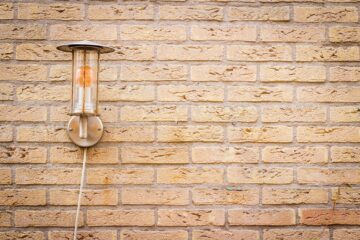There are many ways to paint Your ceiling that are less stressful. It let you judge that you are covering the whole ceiling. In most cases, you paint the ceiling in white and the same shade. That is why it is the simplest process to colour your ceiling. It is even more, easier to colour a new colour coat on white. A right size roller allows you to paint the whole ceiling very easily with the right length extent pole’s help. When you get other things out of your room, the job of painting your ceiling gets quicker with minimum effort.
Basic tips for painting ceiling flat or matte white ceiling whatever your choice is there are few significant tips to follow. They are –
• Flat and matte paints help to hide the faults of your ceiling than the glossy finished highlights. Glossy highlights point to every flow of your ceiling.
• White ceiling gives the perfect illusion that it’s larger than normal. Where the coloured ceiling illustrates smaller than the real.
• The white colour bounces more light, and the reflection makes the room look brighter.
If you already paint your ceiling, you can still paint your ceiling in a new way regardless of any order. However, your wall is dry, and you can use plastic sheets or painter’s tape then paint your ceiling.
1. Tools
• Paint roller frame: A paint roller frame is a paint application tool covering a larger area with paint. It is quicker and reusable. It is framed with a handle.
• Roller Nape: It is yet another important roller that covers the length of its fibre. The shorter the nape, the smoother it will paint the surface.
• Paint tray: It is the most used painter’s palette. It is made of a thin board of wood design to be held by hand.
• Angled paintbrush: Sometimes called a cutting brush, an angled brush makes it easier to paint the cleanliness. It is a sash of the angled brush.
• Drop cloth: A large plastic sheet covering the furniture and floor to protect from the paint.
• Plastic sheeting: Thicker Plastic polymeric materials that separate areas to hold an item. It is used as a barrier during painting painter’s tape.
• Printer’s tape: A pressure-sensitive tape that releases pressure from the adhesive. It is thin and easy to tear.
• Putty knife: It is a hand tool comprising a small blade. It uses a handle in the end and a narrow tip on the other end.
• Extension pole: It is a Multipurpose utility hook kit. It is a telescoping pole that is handy for hanging anything.
• Wood paint whipping stick: Better by wood paint mixing stick it is usable for mixing colour.
• Latex glove: Latex gloves are known as medical gloves; latex gloves are disposable. It is made from rubber latex that resist your hand from having colour.
• Ladder: Self-supporting portable ladders are adjusted with flat steps. But you can not adjust the length.
• Vacuum: It is a devoiding space material. It lowers gas pressure and creates a higher-quality vacuum.
Materials
• stain-blocking primer: Interior primer like water-ink, grease, smoke is blocked with this.
• White ceiling paint: It is the ceiling paint designed for use on the ceiling. Latex formulated and matte sheen is especially suitable for the ceiling.
• Joined compound: It is a white powder made of gypsum dust. It mixes with water to form muddy like cake frosting, which joins drywall sheets and fibre joint tape.
• Grit sandpaper: Grit sandpaper is used for removing scratches from unfinished wood.
• Medium sandpaper: Ranging from 62 hundred grit, it finalizes the shaping of rough wood.
Instructions
1. Prepare room: Remove furniture from your room as possible. Lay drop cloths on the floor or canvas. Plastic sheeting can be applied to furniture left in the room.
2. Remove blockage: Remove light fixtures and especially the smoke detectors. Turn off the power and leave electric boxes to be painted over. Never paint over smoke or Carbon monoxide detectors.
3. Apply for surface protection: In case you paint the ceiling after painting the walls, then take the protection of plastic sheeting. Hang plastic sheeting around vertical surfaces from the ceiling joining point. Use plastic sheeting for the windows and doors too.
4. Prepare the ceiling: Clean the ceiling before applying the paint. Use a vacuum to clean the ceiling surface. It will help apply primer and paint to the surface. Fill every small hole and little cracks in the ceiling. It is a lengthy process because it needs time to dry out. So, you can sand smooth. Sand other rough spots with grits sandpaper. After all, again vacuum the ceiling.
5. Prepare your tools and supplies: Set up your paint tray, liner in the corner of your room, or else you have to rush while painting. Use the can spout for powering the primer into the tray. Put your roller in a roller frame. Dip it into the primer and joint the extension pole. It is advised to use the shortest possible extend pole. Long poles weigh up the pole, which is unnecessary and can give you back pain. Also, they are collapse and give you shoulder and arm pain too.
6. Edging the ceiling: Cut the edges of the ceiling using an angled brush. Paint with primer using an edging tool and let it dry completely. Never forget to use a stain-blocking primer. Remember that primer helps to hide floss and block the view of stain bleed.
7. Paint the edges: After the primer dried, use an angled brush to paint the ceiling paint edges. This brush should be two or three inches wide. Sincerely paint it around the edges and dry before the next step.
8. Paint in grids: Add a fresh liner to the tray and power paint into it. Fill the roller with the paint. You can apply paint on the ceiling in small grids area to keep tracking of your painting. Apply a second coat if necessary. Start new areas after the preceding section of the painted area. To keep track, you can laser light on the ceiling.
We hope these painting tips helped you prepare to paint your ceiling. If you are still looking for a professional and reliable painter and decorator in London feel free to get in touch and give us a call for a free quote.


